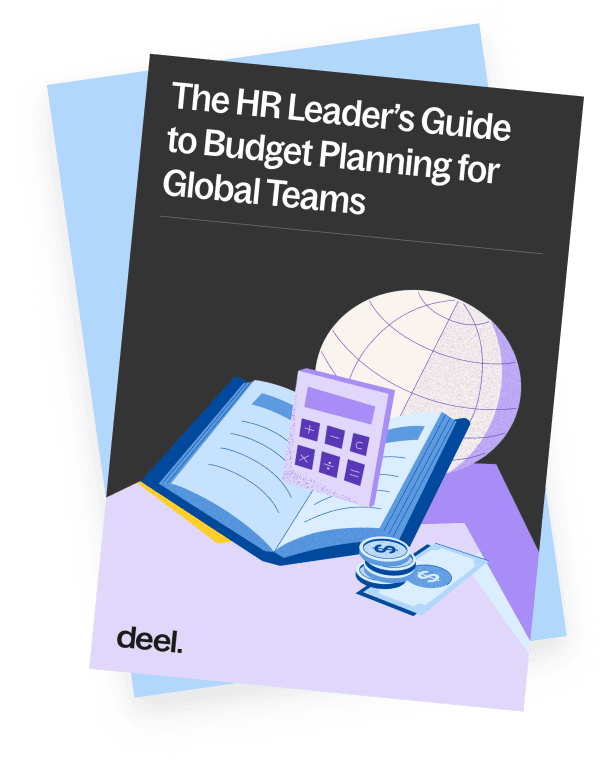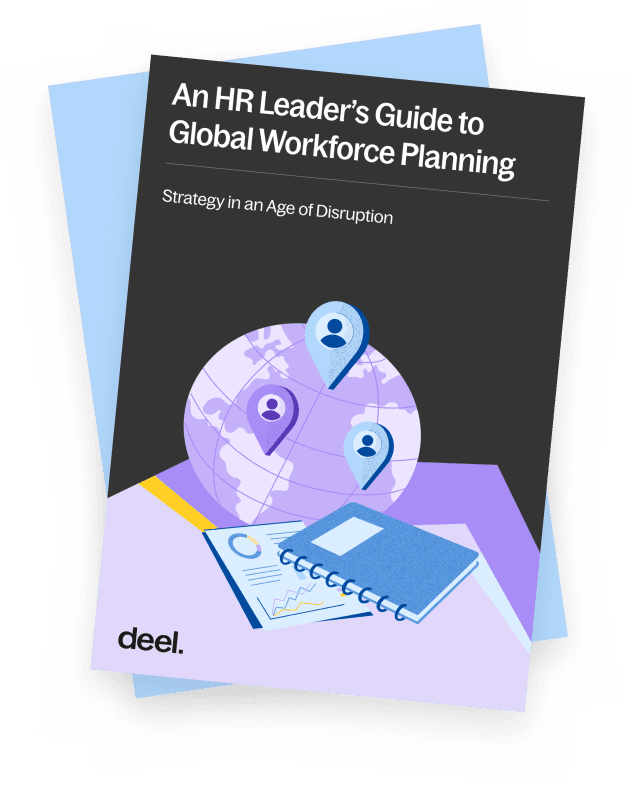Article
17 min read
How to Balance Flexibility and Stability in Global Workforce Planning
Global HR

Author
Deel Team
Last Update
November 27, 2025

Table of Contents
Understanding flexibility and stability as building blocks for workforce planning success
1. Embrace strategic forecasting and workforce planning
2. Implement talent acquisition and retention initiatives
3. Adopt flexible workforce management
4. Invest in human capital development
5. Create a supportive company culture
6. Adjust resource allocation based on business needs
7. Leverage metrics and data for decision-making
Streamline workforce planning with Deel
Key takeaways
- Flexibility and stability are two vital ingredients for successful workforce management; striking a balance between them is key to success
- At the core of building a balanced workforce planning strategy is the ability to accurately forecast future talent requirements in alignment with business needs
- Investing in employee development and promoting a supportive company culture is crucial for building a skilled, stable, and adaptable workforce
Companies are increasingly facing the need to expand their operations across global markets. However, with expansion’s great opportunities come the challenges of managing a diverse and widespread workforce.
These challenges range from practical to cultural and should be addressed together to maximize an organization’s chances of succeeding. They can include:
- Ensuring a cohesive company culture
- Compliance with different regional legal and regulatory frameworks
- Focusing on different cultural approaches to work and business relations
- Ensuring people operations efficiency and scalability
- Facilitating equitable access to opportunities
- Aligning with evolving business needs
Two factors heavily influence business operations and interactions within any organization: flexibility and stability. Both aspects are crucial to success, as is the ability to strike a balance between their ever-changing interactions.
This article aims to provide actionable and scalable tips that businesses looking to expand on the global market can implement to achieve this delicate balance.
Understanding flexibility and stability as building blocks for workforce planning success
Before we dive into our list of actionable tips, it may be a good idea to better understand why flexibility and stability in the workplace are so important.
Flexibility allows a business to adapt quickly to market changes, workforce fluctuations, and unexpected challenges like the ones experienced during the pandemic a few years ago. Facilitating workforce agility through work arrangements, such as remote work and flexible work hours, also contributes to improved work-life balance and well-being of employees.
Stability provides a sense of security to employees, ensuring they feel valued and part of the company’s long-term vision. Moreover, implementing a stable environment involves clear communication of business goals, predictable work arrangements, standardized processes, and consistent support for employee development.
While the balance between the two may change from one organization to another, both are necessary for the solid foundations of a business.
Now, let’s see how to strike this balance in practice.
1. Embrace strategic forecasting and workforce planning
Incorporate strategic forecasting into your workforce planning strategy. This involves understanding your current workforce, identifying future needs based on business strategy, and forecasting potential shortages or surpluses in talent pools.
By aligning workforce planning with strategic goals, you can predict fluctuations and prepare for future workforce requirements, balancing the allocation of human capital effectively and reducing the friction of transition phases within your organization.
How to get started
- Align workforce planning with overall business strategy
- Forecast future talent needs and potential shortages
- Utilize data analytics for accurate workforce predictions
- Enforce guardrails around your workforce planning to ensure you maintain course
- Avoid falling behind and relying on a reactive approach to workforce planning
Working with Deel has been an invaluable part of our expansion journey
—Leanne Schofield,
Head of People
Deel Workforce Planning
2. Implement talent acquisition and retention initiatives
A robust talent acquisition strategy is key to accessing top talent across global markets. This includes identifying skill gaps and competencies needed for future success and expanding talent pools through diverse hiring practices.
Equally important is retention, which ensures the stability of your current workforce. Implement initiatives focusing on career development, mentoring, upskilling, and a supportive work environment to keep your employees engaged and committed.
How to get started
- Identify skill gaps and required competencies for future needs
- Leverage alternative networks and employee referrals to increase your talent pool
- Implement career development initiatives that align with your needs
- Focus on upskilling and reskilling to maintain an engaged workforce
- Make retention a key metric for your people management success
Deel Engage
3. Adopt flexible workforce management
Embrace the concept of a flexible workforce by offering varied work arrangements, such as part-time, full-time, remote work, hybrid work, and outsourcing options. This adaptability allows your company to respond to business needs promptly while catering to your employees' well-being and work-life balance.
Embrace this variety of options as an opportunity rather than added complexity because there are tools available to make managing it easy. Automation and technology have a crucial role in facilitating remote work and ensuring continuity of operations, regardless of physical location, so make sure the right tools support your flexible or remote work policies.
How to get started
- Listen to what your workers want and need
- Offer work arrangements that align with the needs of workers and the organization
- Prioritize employee well-being and work-life balance
- Leverage technology for remote work facilitation
- Don’t shy away from exploring different approaches to work (automation, asynchronous communication, etc.)
It’s great being able to direct employees to the support line where everyone is so helpful. And it seems that every time I ask Deel, ‘are you set up in Morocco?’ or ‘are you set up in Belgium?’ for example, the answer is always yes. I’ve evaluated other solutions, but we’re sticking with Deel because it covers anywhere and everywhere and gives us the confidence that things are being done properly.
—Harry Rillstone,
Director, Legal and Compliance
4. Invest in human capital development
Investing in the development of your workers is important for maintaining a stable and skilled workforce. This includes providing opportunities for acquiring new skills through training and upskilling programs.
By developing a culture of learning and growth, you ensure that your workforce is equipped with the right skills to meet the demands of a dynamic business environment while limiting the risk of your organization being vulnerable to unexpected skill gaps affecting your work and reducing the amount of work your human capital management operations require.
How to get started
- Provide opportunities for acquiring new skills
- Implement training and upskilling programs
- Foster a culture of learning and growth
- Equip the workforce with the tools they need to grow
- Start looking at employee development as an investment in workforce stability
We needed a way to ensure that the right talents were hired compliantly and managed in the most efficient way possible. With Deel, we can find and hire top talent fast, no matter where they live.
—Lavinia Radu,
Head of Human Resources
5. Create a supportive company culture
Company culture is the cornerstone of both stability and flexibility. Establish a culture that values transparency, adaptability, and employee well-being. Initiatives that promote inclusion, diversity, mobility, and a healthy work-life balance contribute to a positive work environment, attracting and retaining top talent. Mentoring programs and transparent communication channels between management and employees further enhance this culture, ensuring that everyone is aligned with the business strategy and feels supported in their roles.
Ensure the values of flexibility and stability are enshrined in your cultural communications from the moment of onboarding, as are the guidelines and processes you ensure they are properly implemented and promoted.
How to get started
- Value transparency, adaptability, and well-being in company culture
- Promote inclusion, diversity, and work-life balance
- Make active efforts to attract and retain top talent
- Implement mentoring programs for employee support
- Boost culture by promoting open communication channels
With Deel, we have an easy remote work solution powered by a user-friendly platform and a seamless process. This has been helpful in ensuring we didn’t lose key staff and the deep corporate knowledge and skills that are hugely beneficial to our business.
—Lysette Randall,
Executive, HR Performance & Partnering
6. Adjust resource allocation based on business needs
Regularly assess the allocation of human resources in line with changing business needs and goals. This may involve restructuring teams, delegating new responsibilities, or even downsizing certain areas to reallocate resources more efficiently.
Being proactive in these adjustments ensures that your company remains agile while providing job security for your employees through transparent communication and well-planned redeployment strategies.
How to get started
- Regularly assess human resource allocation for business needs
- Restructure teams based on shifting goals
- Delegate new responsibilities efficiently
- Maintain transparency in resource reallocation
- Utilize redeployment strategies for job security
It's been a very collaborative relationship. The experience was really fast, and the team has always been very responsive.
—Mars Escobin,
Product Manager

7. Leverage metrics and data for decision-making
Utilize metrics and data analytics to monitor the effectiveness of your workforce management strategies. Key performance indicators related to staffing, retention rates, employee satisfaction, and productivity provide valuable insights into areas of improvement and success. Data-driven decision-making enables you to fine-tune your strategies for balancing flexibility and stability, ensuring they align with both business and employee needs.
How to get started
- Build processes that rely on data-driven decisions
- Regularly monitor staffing, retention, satisfaction, and productivity metrics
- Identify improvement areas through data insights
- Fine-tune strategies with data-driven decisions
- Align strategies with business and employee needs before rolling them out

Streamline workforce planning with Deel
Deel offers top-notch solutions to streamline your workforce planning process.
Unlock workforce insights, analyze skill gaps, track internal mobility, and forecast hiring needs so teams have the right talent in the right roles and you can build a workforce ready for growth. Additionally, you can leverage AI insights and empower your team to make confident, strategic decisions across 150+ countries.
Additionally, Deel helps companies of all sizes smoothen the process of accessing a global workforce, from dealing with contracts and payments of employees and contractors to managing talent, and visa support.
Discover how Deel can help your organization thrive in the global workplace.
Live Demo
Get a live walkthrough of the Deel platform

















